Managerial Finance Portfolio: Tesco and Sainsbury Financial Analysis
VerifiedAdded on 2023/01/03
|18
|3924
|83
Portfolio
AI Summary
This portfolio is a comprehensive analysis of financial performance and investment strategies. It begins with an introduction to managerial finance, emphasizing its role in business decision-making. Portfolio 1 focuses on the calculation and analysis of financial ratios for Tesco and Sainsbury, including current ratio, quick ratio, net profit margin, gross profit margin, gearing ratio, P/E ratio, and others. It evaluates the financial positions of both companies, identifies areas for business performance improvement, and discusses the limitations of relying solely on financial ratios. Portfolio 2 delves into capital investment appraisal, examining two mutually exclusive projects and their respective plant investments. The report provides detailed calculations and analyses, offering valuable insights for financial managers and investors. References are provided at the end.
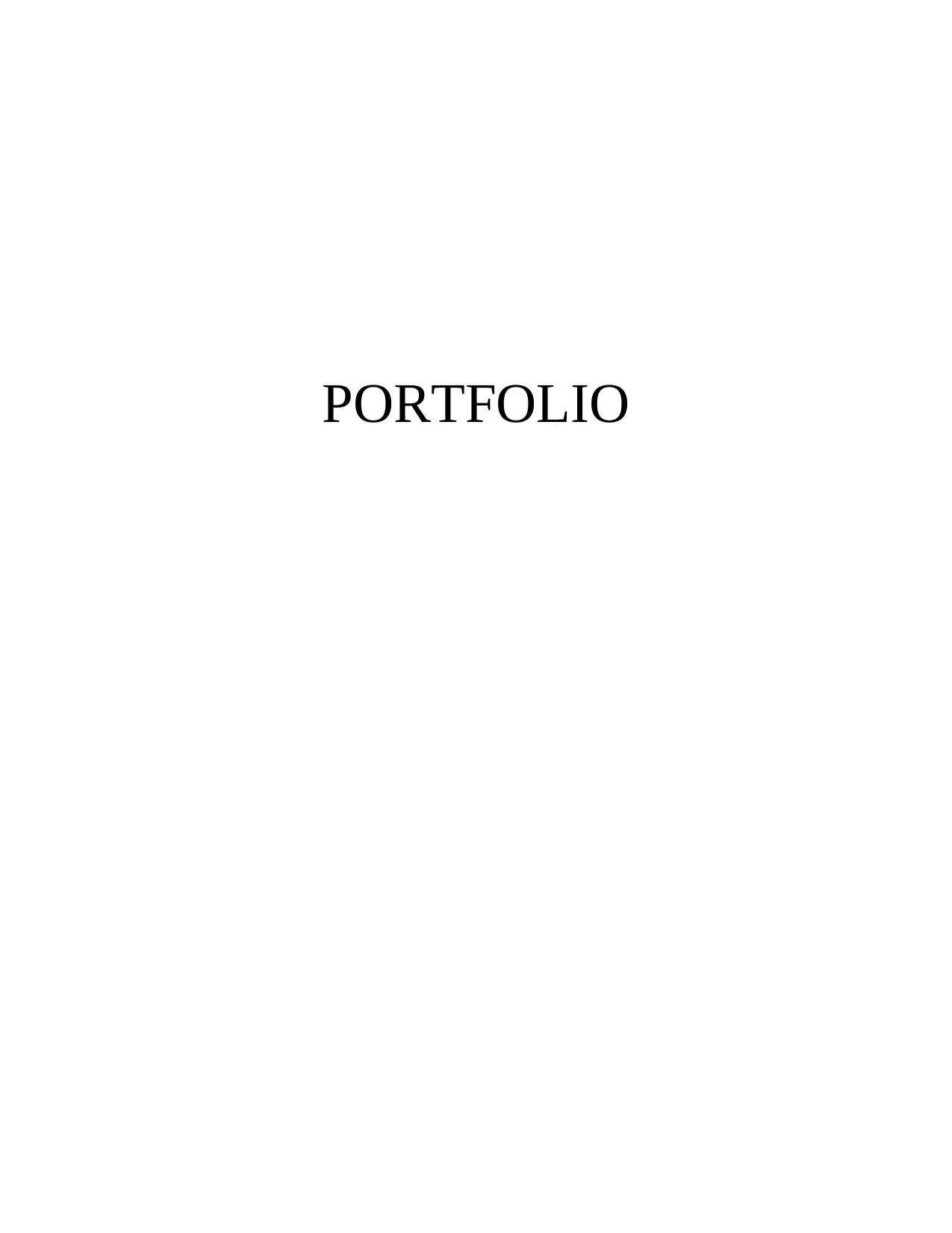
PORTFOLIO
Paraphrase This Document
Need a fresh take? Get an instant paraphrase of this document with our AI Paraphraser
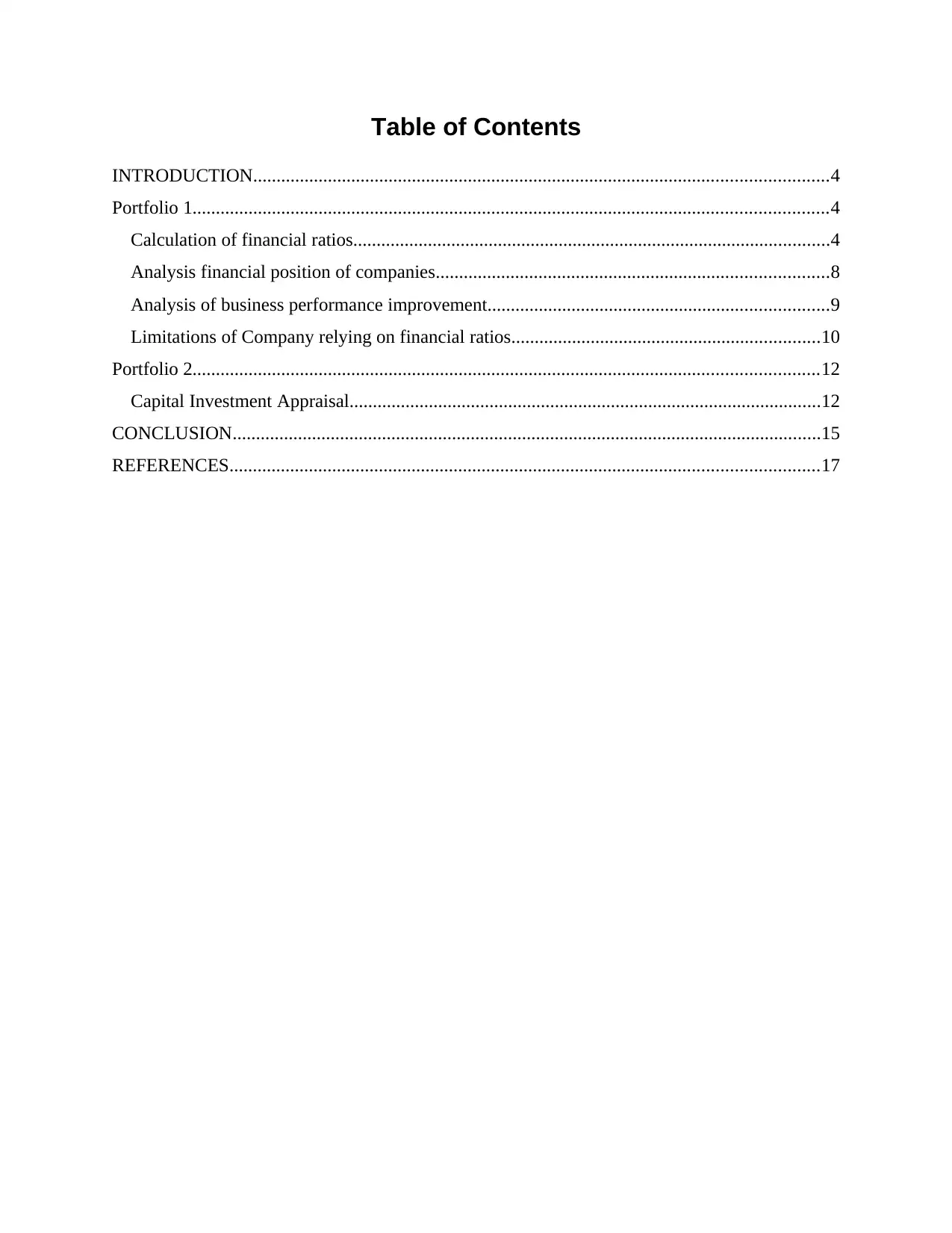
Table of Contents
INTRODUCTION...........................................................................................................................4
Portfolio 1........................................................................................................................................4
Calculation of financial ratios......................................................................................................4
Analysis financial position of companies....................................................................................8
Analysis of business performance improvement.........................................................................9
Limitations of Company relying on financial ratios..................................................................10
Portfolio 2......................................................................................................................................12
Capital Investment Appraisal.....................................................................................................12
CONCLUSION..............................................................................................................................15
REFERENCES..............................................................................................................................17
INTRODUCTION...........................................................................................................................4
Portfolio 1........................................................................................................................................4
Calculation of financial ratios......................................................................................................4
Analysis financial position of companies....................................................................................8
Analysis of business performance improvement.........................................................................9
Limitations of Company relying on financial ratios..................................................................10
Portfolio 2......................................................................................................................................12
Capital Investment Appraisal.....................................................................................................12
CONCLUSION..............................................................................................................................15
REFERENCES..............................................................................................................................17
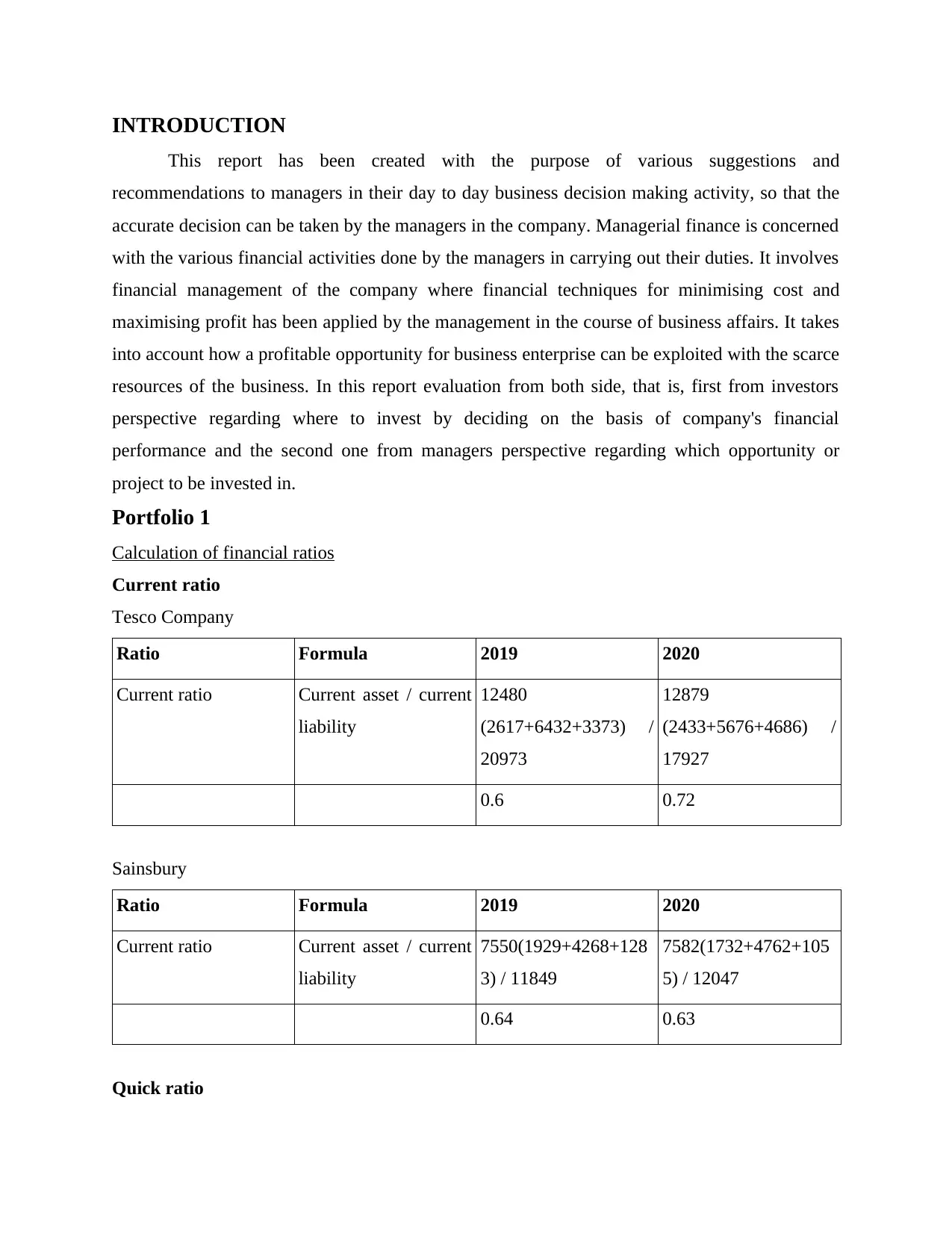
INTRODUCTION
This report has been created with the purpose of various suggestions and
recommendations to managers in their day to day business decision making activity, so that the
accurate decision can be taken by the managers in the company. Managerial finance is concerned
with the various financial activities done by the managers in carrying out their duties. It involves
financial management of the company where financial techniques for minimising cost and
maximising profit has been applied by the management in the course of business affairs. It takes
into account how a profitable opportunity for business enterprise can be exploited with the scarce
resources of the business. In this report evaluation from both side, that is, first from investors
perspective regarding where to invest by deciding on the basis of company's financial
performance and the second one from managers perspective regarding which opportunity or
project to be invested in.
Portfolio 1
Calculation of financial ratios
Current ratio
Tesco Company
Ratio Formula 2019 2020
Current ratio Current asset / current
liability
12480
(2617+6432+3373) /
20973
12879
(2433+5676+4686) /
17927
0.6 0.72
Sainsbury
Ratio Formula 2019 2020
Current ratio Current asset / current
liability
7550(1929+4268+128
3) / 11849
7582(1732+4762+105
5) / 12047
0.64 0.63
Quick ratio
This report has been created with the purpose of various suggestions and
recommendations to managers in their day to day business decision making activity, so that the
accurate decision can be taken by the managers in the company. Managerial finance is concerned
with the various financial activities done by the managers in carrying out their duties. It involves
financial management of the company where financial techniques for minimising cost and
maximising profit has been applied by the management in the course of business affairs. It takes
into account how a profitable opportunity for business enterprise can be exploited with the scarce
resources of the business. In this report evaluation from both side, that is, first from investors
perspective regarding where to invest by deciding on the basis of company's financial
performance and the second one from managers perspective regarding which opportunity or
project to be invested in.
Portfolio 1
Calculation of financial ratios
Current ratio
Tesco Company
Ratio Formula 2019 2020
Current ratio Current asset / current
liability
12480
(2617+6432+3373) /
20973
12879
(2433+5676+4686) /
17927
0.6 0.72
Sainsbury
Ratio Formula 2019 2020
Current ratio Current asset / current
liability
7550(1929+4268+128
3) / 11849
7582(1732+4762+105
5) / 12047
0.64 0.63
Quick ratio
⊘ This is a preview!⊘
Do you want full access?
Subscribe today to unlock all pages.

Trusted by 1+ million students worldwide

Tesco Company
Ratio Formula 2019 2020
Quick ratio Current asset -
Inventory/ current
liability
9863 (12480-2617) /
20973
10446 (12879-2433) /
17927
0.47 0.58
Sainsbury
Ratio Formula 2019 2020
Quick ratio Current asset -
Inventory/ current
liability
5621(7550-1929) /
11849
5850(7582-1732) /
12047
0.47 0.49
Net profit margin
Tesco Company
Ratio Formula 2019 2020
Net profit margin Net profit / sales *100 1270/63911*100 935/64760*100
1.99% 1.44%
Sainsbury
Ratio Formula 2019 2020
Net profit margin Net profit / sales *100 186/29007*100 152/28993*100
0.64% 0.52%
Gross profit margin
Tesco Company
Ratio Formula 2019 2020
Ratio Formula 2019 2020
Quick ratio Current asset -
Inventory/ current
liability
9863 (12480-2617) /
20973
10446 (12879-2433) /
17927
0.47 0.58
Sainsbury
Ratio Formula 2019 2020
Quick ratio Current asset -
Inventory/ current
liability
5621(7550-1929) /
11849
5850(7582-1732) /
12047
0.47 0.49
Net profit margin
Tesco Company
Ratio Formula 2019 2020
Net profit margin Net profit / sales *100 1270/63911*100 935/64760*100
1.99% 1.44%
Sainsbury
Ratio Formula 2019 2020
Net profit margin Net profit / sales *100 186/29007*100 152/28993*100
0.64% 0.52%
Gross profit margin
Tesco Company
Ratio Formula 2019 2020
Paraphrase This Document
Need a fresh take? Get an instant paraphrase of this document with our AI Paraphraser

Gross profit margin Gross profit / sales
*100
4514/63911*100 4250/64760*100
7.06% 6.56%
Sainsbury
Ratio Formula 2019 2020
Gross profit margin Gross profit / sales
*100
1882/29007*100 1901/28993*100
6.49% 6.56%
Gearing ratio
Tesco Company
Ratio Formula 2019 2020
Gearing ratio EBIT / Total interest 2464/913 2093/828
2.7 2.53
Sainsbury
Ratio Formula 2019 2020
Gearing ratio EBIT /Total interest 620/422 645/366
1.47 1.76
P/E Ratio
Tesco Company
Ratio Formula 2019 2020
P/E ratio Share price /Earning
per share
208.1/14.19 226.2/12.75
14.67 17.74
*100
4514/63911*100 4250/64760*100
7.06% 6.56%
Sainsbury
Ratio Formula 2019 2020
Gross profit margin Gross profit / sales
*100
1882/29007*100 1901/28993*100
6.49% 6.56%
Gearing ratio
Tesco Company
Ratio Formula 2019 2020
Gearing ratio EBIT / Total interest 2464/913 2093/828
2.7 2.53
Sainsbury
Ratio Formula 2019 2020
Gearing ratio EBIT /Total interest 620/422 645/366
1.47 1.76
P/E Ratio
Tesco Company
Ratio Formula 2019 2020
P/E ratio Share price /Earning
per share
208.1/14.19 226.2/12.75
14.67 17.74
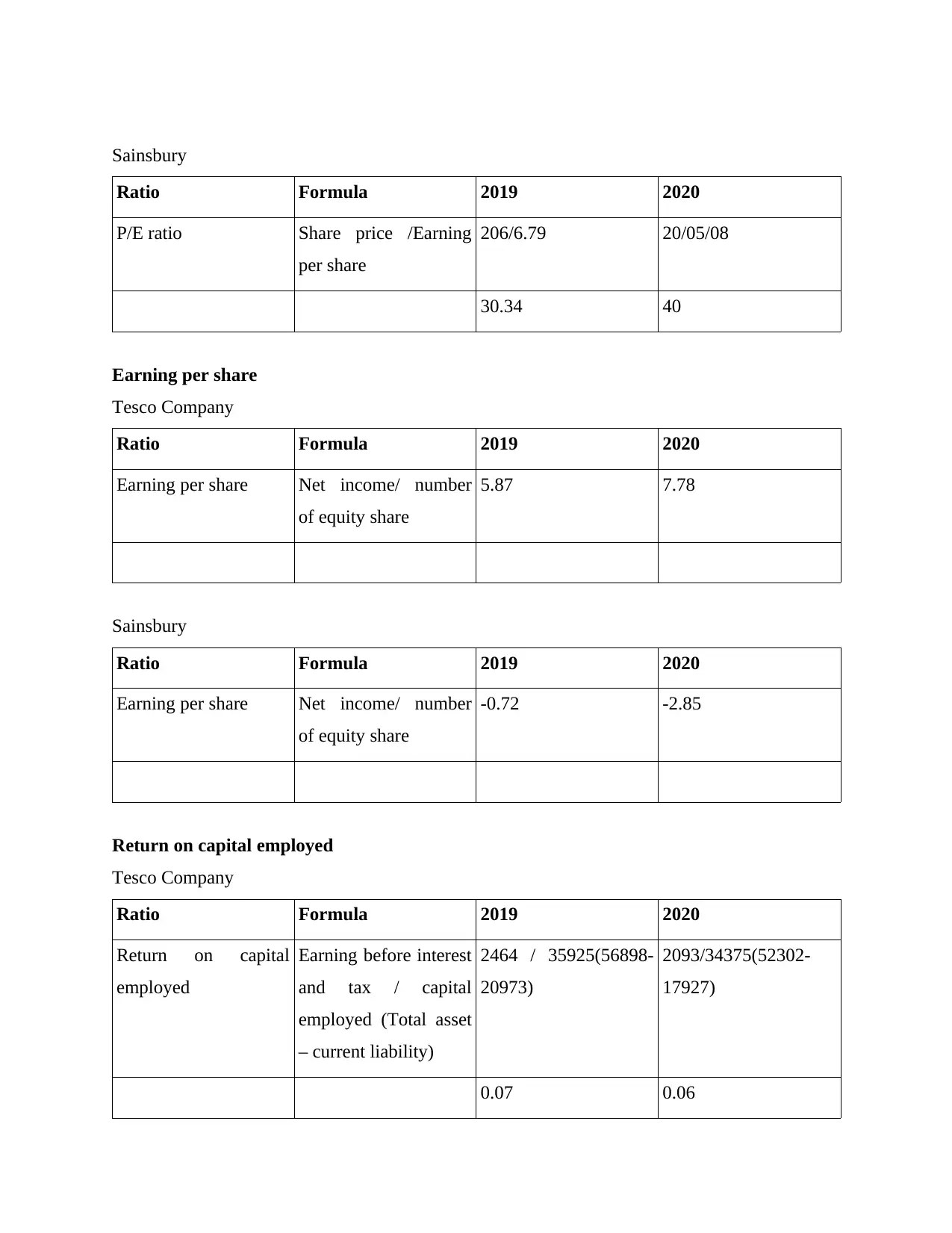
Sainsbury
Ratio Formula 2019 2020
P/E ratio Share price /Earning
per share
206/6.79 20/05/08
30.34 40
Earning per share
Tesco Company
Ratio Formula 2019 2020
Earning per share Net income/ number
of equity share
5.87 7.78
Sainsbury
Ratio Formula 2019 2020
Earning per share Net income/ number
of equity share
-0.72 -2.85
Return on capital employed
Tesco Company
Ratio Formula 2019 2020
Return on capital
employed
Earning before interest
and tax / capital
employed (Total asset
– current liability)
2464 / 35925(56898-
20973)
2093/34375(52302-
17927)
0.07 0.06
Ratio Formula 2019 2020
P/E ratio Share price /Earning
per share
206/6.79 20/05/08
30.34 40
Earning per share
Tesco Company
Ratio Formula 2019 2020
Earning per share Net income/ number
of equity share
5.87 7.78
Sainsbury
Ratio Formula 2019 2020
Earning per share Net income/ number
of equity share
-0.72 -2.85
Return on capital employed
Tesco Company
Ratio Formula 2019 2020
Return on capital
employed
Earning before interest
and tax / capital
employed (Total asset
– current liability)
2464 / 35925(56898-
20973)
2093/34375(52302-
17927)
0.07 0.06
⊘ This is a preview!⊘
Do you want full access?
Subscribe today to unlock all pages.

Trusted by 1+ million students worldwide

Sainsbury
Ratio Formula 2019 2020
Return on capital
employed
Earning before interest
and tax / capital
employed (Total asset
– current liability)
620/16162(28011-
11849)
645/15890(27937-
12047)
0.04 0.04
Average inventory turnover period
Tesco Company
Ratio Formula 2019 2020
Average inventory
turnover period
Cost of good sold
/average stock
61272/2441(2264+261
7/2)
62199/2525(2617+243
3/2)
25.1 24.63
Sainsbury
Ratio Formula 2019 2020
Average inventory
turnover period
Cost of good sold
/average stock
28406/1869.5(1810+1
929/2)
28343/1830.5(1929+1
732/2)
15.19 15.48
Dividend payout ratio
Tesco Company
Ratio Formula 2019 2020
Dividend payout ratio Dividend per share /
Earning per share
3.67/13.04 6.75/9.54
0.28 0.71
Ratio Formula 2019 2020
Return on capital
employed
Earning before interest
and tax / capital
employed (Total asset
– current liability)
620/16162(28011-
11849)
645/15890(27937-
12047)
0.04 0.04
Average inventory turnover period
Tesco Company
Ratio Formula 2019 2020
Average inventory
turnover period
Cost of good sold
/average stock
61272/2441(2264+261
7/2)
62199/2525(2617+243
3/2)
25.1 24.63
Sainsbury
Ratio Formula 2019 2020
Average inventory
turnover period
Cost of good sold
/average stock
28406/1869.5(1810+1
929/2)
28343/1830.5(1929+1
732/2)
15.19 15.48
Dividend payout ratio
Tesco Company
Ratio Formula 2019 2020
Dividend payout ratio Dividend per share /
Earning per share
3.67/13.04 6.75/9.54
0.28 0.71
Paraphrase This Document
Need a fresh take? Get an instant paraphrase of this document with our AI Paraphraser

Sainsbury
Ratio Formula 2019 2020
Dividend payout ratio Dividend per share /
Earning per share
10.2/7.5 11.2/5.8
1.36 1.93
Analysis financial position of companies
Tesco company is performing effectively as the gross profit ratio of company indicate as
7.06% in the year 2019 which reduced to 6.56% in the year 2020 whereas the profit ratio of the
Sainsbury Company are reported as 6.49% and 6.56% of both the financial years. The lower
gross profit ratios are further reflected under the net profit ratio of company that identified as
1.99% and 1.44% on the other hand the profit ratio of Sainsbury Company are reported as .64%
and .52%.Profitability directly reflected the low performance of the Sainsbury Company in
comparison to the Tesco Company (Rashid, 2018). Gearing ratios also indicate that Tesco
Company performed more efficiently as compare to the Tesco Company. P/E ratio of the
Sainsbury Company are much impressive as the Tesco Company could only maintain the ratio as
14.67 and 17.74 on the other hand Sainsbury Company could report the ratios as 30.34 and 40.
The overall performance of the company is also reflected in the earning per share recorded by the
company. Tesco Company could cater the earning per share to its shareholders on the rate of
5.87 and 7.78 whereas the Sainsbury Company could offer its EPS In negative amount. This also
reflect about the financial performance of both the organisations.
Analysis of business performance improvement
Speaking of current ratio analysis of Tesco and Sainsbury, the ratio of both were around
same at 0.6 in 2019 but in 2019 Tesco has taken the lead therefore, Tesco has been able to get the
balance better of current assets and current liabilities. Sainsbury has maintained almost same
ratios but still far from reaching the 1:1 standard ratio. Sainsbury current assets have increased
only marginally compared to current liabilities. Sainsbury will have to increase its current assets
Ratio Formula 2019 2020
Dividend payout ratio Dividend per share /
Earning per share
10.2/7.5 11.2/5.8
1.36 1.93
Analysis financial position of companies
Tesco company is performing effectively as the gross profit ratio of company indicate as
7.06% in the year 2019 which reduced to 6.56% in the year 2020 whereas the profit ratio of the
Sainsbury Company are reported as 6.49% and 6.56% of both the financial years. The lower
gross profit ratios are further reflected under the net profit ratio of company that identified as
1.99% and 1.44% on the other hand the profit ratio of Sainsbury Company are reported as .64%
and .52%.Profitability directly reflected the low performance of the Sainsbury Company in
comparison to the Tesco Company (Rashid, 2018). Gearing ratios also indicate that Tesco
Company performed more efficiently as compare to the Tesco Company. P/E ratio of the
Sainsbury Company are much impressive as the Tesco Company could only maintain the ratio as
14.67 and 17.74 on the other hand Sainsbury Company could report the ratios as 30.34 and 40.
The overall performance of the company is also reflected in the earning per share recorded by the
company. Tesco Company could cater the earning per share to its shareholders on the rate of
5.87 and 7.78 whereas the Sainsbury Company could offer its EPS In negative amount. This also
reflect about the financial performance of both the organisations.
Analysis of business performance improvement
Speaking of current ratio analysis of Tesco and Sainsbury, the ratio of both were around
same at 0.6 in 2019 but in 2019 Tesco has taken the lead therefore, Tesco has been able to get the
balance better of current assets and current liabilities. Sainsbury has maintained almost same
ratios but still far from reaching the 1:1 standard ratio. Sainsbury current assets have increased
only marginally compared to current liabilities. Sainsbury will have to increase its current assets

in form of cash, receivables etc. so that it can pay off its current liabilities with help of assets and
also improve working capital (Zolfani, Yazdani and Zavadskas, 2018).
Speaking of quick ratio, Tesco is again better in 2020 with ratio standing at 0.58
compared to Sainsbury ratio of 0.49. This means Tesco is better at current assets and thus
liquidity also. Sainsbury has a decrease in inventory here which is a good sign in 2020 analysis,
but the liabilities have simultaneously increased more. Sainsbury has to increase its working
capital by generating more current assets; one way can be suggested to improve its debt
collection period to have more cash component.
Speaking of net and gross profit margin, Tesco fares better than Sainsbury. Sainsbury
will have to increase its earnings according to volume of sales. In net margin, it will have to
decrease upon operational expenses to increase net profit.
Speaking of Gearing ratio, the performance of Tesco again stands better. This ratio
indicates of how the company can pay interest better on its outstanding debt. Although Sainsbury
has performed above benchmark of 1.5 still it can improve its ratio to meet its interest expenses.
Sainsbury will have to increase its revenue in order to meet interest expenses (Camin and et.al.,
2016).
Speaking of P/E ratio, Sainsbury ratio is higher to that of Tesco but a lower ratio will suit
the investor requirements as it can be that market value of share is overhauled. Same in the case
of EPS, Sainsbury has registered EPS in negative. Sainsbury can increase its EPS by lowering
the costs and utilize share buybacks option.
Speaking of Return on Capital Employed, Tesco has fared better than Sainsbury.
Sainsbury has registered ratio a little less. It will have to decrease its operational expenses and
increase earnings (Assrani, D. and et.al., 2018).
Talking of Dividend payout ratio, Sainsbury fares better than Tesco but it also means that
in case of crisis, the company won't be able to afford dividend cuts. A lower dividend payout
ratio in the range of 35 to 55 % will be better.
Speaking of Average Inventory Turnover ratio, Sainsbury has fared better than Tesco as
the turnover of inventory has been less which is better compared to higher ratio. Tesco's
inventory has increased but accordingly it will have to increase its sales.
also improve working capital (Zolfani, Yazdani and Zavadskas, 2018).
Speaking of quick ratio, Tesco is again better in 2020 with ratio standing at 0.58
compared to Sainsbury ratio of 0.49. This means Tesco is better at current assets and thus
liquidity also. Sainsbury has a decrease in inventory here which is a good sign in 2020 analysis,
but the liabilities have simultaneously increased more. Sainsbury has to increase its working
capital by generating more current assets; one way can be suggested to improve its debt
collection period to have more cash component.
Speaking of net and gross profit margin, Tesco fares better than Sainsbury. Sainsbury
will have to increase its earnings according to volume of sales. In net margin, it will have to
decrease upon operational expenses to increase net profit.
Speaking of Gearing ratio, the performance of Tesco again stands better. This ratio
indicates of how the company can pay interest better on its outstanding debt. Although Sainsbury
has performed above benchmark of 1.5 still it can improve its ratio to meet its interest expenses.
Sainsbury will have to increase its revenue in order to meet interest expenses (Camin and et.al.,
2016).
Speaking of P/E ratio, Sainsbury ratio is higher to that of Tesco but a lower ratio will suit
the investor requirements as it can be that market value of share is overhauled. Same in the case
of EPS, Sainsbury has registered EPS in negative. Sainsbury can increase its EPS by lowering
the costs and utilize share buybacks option.
Speaking of Return on Capital Employed, Tesco has fared better than Sainsbury.
Sainsbury has registered ratio a little less. It will have to decrease its operational expenses and
increase earnings (Assrani, D. and et.al., 2018).
Talking of Dividend payout ratio, Sainsbury fares better than Tesco but it also means that
in case of crisis, the company won't be able to afford dividend cuts. A lower dividend payout
ratio in the range of 35 to 55 % will be better.
Speaking of Average Inventory Turnover ratio, Sainsbury has fared better than Tesco as
the turnover of inventory has been less which is better compared to higher ratio. Tesco's
inventory has increased but accordingly it will have to increase its sales.
⊘ This is a preview!⊘
Do you want full access?
Subscribe today to unlock all pages.

Trusted by 1+ million students worldwide
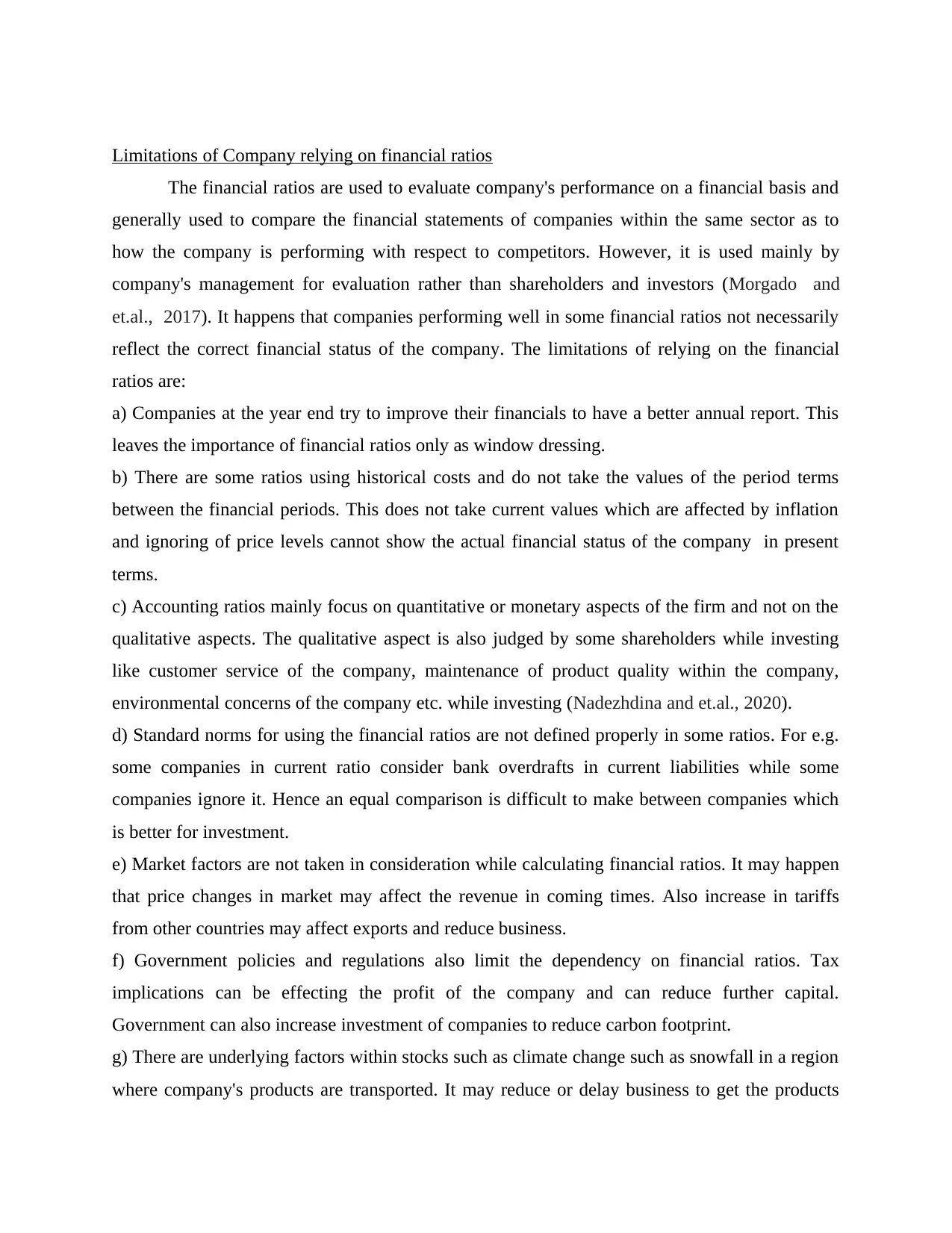
Limitations of Company relying on financial ratios
The financial ratios are used to evaluate company's performance on a financial basis and
generally used to compare the financial statements of companies within the same sector as to
how the company is performing with respect to competitors. However, it is used mainly by
company's management for evaluation rather than shareholders and investors (Morgado and
et.al., 2017). It happens that companies performing well in some financial ratios not necessarily
reflect the correct financial status of the company. The limitations of relying on the financial
ratios are:
a) Companies at the year end try to improve their financials to have a better annual report. This
leaves the importance of financial ratios only as window dressing.
b) There are some ratios using historical costs and do not take the values of the period terms
between the financial periods. This does not take current values which are affected by inflation
and ignoring of price levels cannot show the actual financial status of the company in present
terms.
c) Accounting ratios mainly focus on quantitative or monetary aspects of the firm and not on the
qualitative aspects. The qualitative aspect is also judged by some shareholders while investing
like customer service of the company, maintenance of product quality within the company,
environmental concerns of the company etc. while investing (Nadezhdina and et.al., 2020).
d) Standard norms for using the financial ratios are not defined properly in some ratios. For e.g.
some companies in current ratio consider bank overdrafts in current liabilities while some
companies ignore it. Hence an equal comparison is difficult to make between companies which
is better for investment.
e) Market factors are not taken in consideration while calculating financial ratios. It may happen
that price changes in market may affect the revenue in coming times. Also increase in tariffs
from other countries may affect exports and reduce business.
f) Government policies and regulations also limit the dependency on financial ratios. Tax
implications can be effecting the profit of the company and can reduce further capital.
Government can also increase investment of companies to reduce carbon footprint.
g) There are underlying factors within stocks such as climate change such as snowfall in a region
where company's products are transported. It may reduce or delay business to get the products
The financial ratios are used to evaluate company's performance on a financial basis and
generally used to compare the financial statements of companies within the same sector as to
how the company is performing with respect to competitors. However, it is used mainly by
company's management for evaluation rather than shareholders and investors (Morgado and
et.al., 2017). It happens that companies performing well in some financial ratios not necessarily
reflect the correct financial status of the company. The limitations of relying on the financial
ratios are:
a) Companies at the year end try to improve their financials to have a better annual report. This
leaves the importance of financial ratios only as window dressing.
b) There are some ratios using historical costs and do not take the values of the period terms
between the financial periods. This does not take current values which are affected by inflation
and ignoring of price levels cannot show the actual financial status of the company in present
terms.
c) Accounting ratios mainly focus on quantitative or monetary aspects of the firm and not on the
qualitative aspects. The qualitative aspect is also judged by some shareholders while investing
like customer service of the company, maintenance of product quality within the company,
environmental concerns of the company etc. while investing (Nadezhdina and et.al., 2020).
d) Standard norms for using the financial ratios are not defined properly in some ratios. For e.g.
some companies in current ratio consider bank overdrafts in current liabilities while some
companies ignore it. Hence an equal comparison is difficult to make between companies which
is better for investment.
e) Market factors are not taken in consideration while calculating financial ratios. It may happen
that price changes in market may affect the revenue in coming times. Also increase in tariffs
from other countries may affect exports and reduce business.
f) Government policies and regulations also limit the dependency on financial ratios. Tax
implications can be effecting the profit of the company and can reduce further capital.
Government can also increase investment of companies to reduce carbon footprint.
g) There are underlying factors within stocks such as climate change such as snowfall in a region
where company's products are transported. It may reduce or delay business to get the products
Paraphrase This Document
Need a fresh take? Get an instant paraphrase of this document with our AI Paraphraser
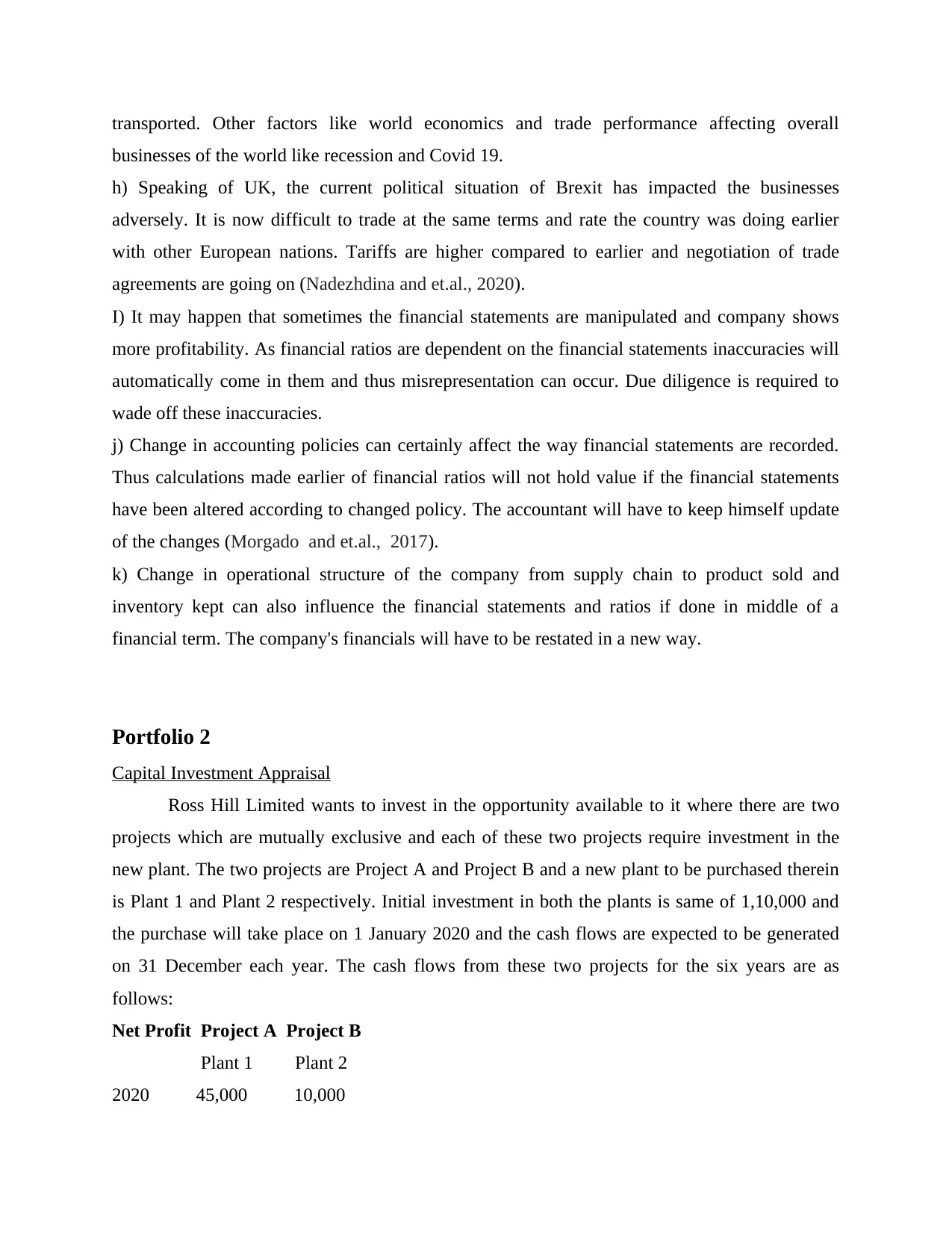
transported. Other factors like world economics and trade performance affecting overall
businesses of the world like recession and Covid 19.
h) Speaking of UK, the current political situation of Brexit has impacted the businesses
adversely. It is now difficult to trade at the same terms and rate the country was doing earlier
with other European nations. Tariffs are higher compared to earlier and negotiation of trade
agreements are going on (Nadezhdina and et.al., 2020).
I) It may happen that sometimes the financial statements are manipulated and company shows
more profitability. As financial ratios are dependent on the financial statements inaccuracies will
automatically come in them and thus misrepresentation can occur. Due diligence is required to
wade off these inaccuracies.
j) Change in accounting policies can certainly affect the way financial statements are recorded.
Thus calculations made earlier of financial ratios will not hold value if the financial statements
have been altered according to changed policy. The accountant will have to keep himself update
of the changes (Morgado and et.al., 2017).
k) Change in operational structure of the company from supply chain to product sold and
inventory kept can also influence the financial statements and ratios if done in middle of a
financial term. The company's financials will have to be restated in a new way.
Portfolio 2
Capital Investment Appraisal
Ross Hill Limited wants to invest in the opportunity available to it where there are two
projects which are mutually exclusive and each of these two projects require investment in the
new plant. The two projects are Project A and Project B and a new plant to be purchased therein
is Plant 1 and Plant 2 respectively. Initial investment in both the plants is same of 1,10,000 and
the purchase will take place on 1 January 2020 and the cash flows are expected to be generated
on 31 December each year. The cash flows from these two projects for the six years are as
follows:
Net Profit Project A Project B
Plant 1 Plant 2
2020 45,000 10,000
businesses of the world like recession and Covid 19.
h) Speaking of UK, the current political situation of Brexit has impacted the businesses
adversely. It is now difficult to trade at the same terms and rate the country was doing earlier
with other European nations. Tariffs are higher compared to earlier and negotiation of trade
agreements are going on (Nadezhdina and et.al., 2020).
I) It may happen that sometimes the financial statements are manipulated and company shows
more profitability. As financial ratios are dependent on the financial statements inaccuracies will
automatically come in them and thus misrepresentation can occur. Due diligence is required to
wade off these inaccuracies.
j) Change in accounting policies can certainly affect the way financial statements are recorded.
Thus calculations made earlier of financial ratios will not hold value if the financial statements
have been altered according to changed policy. The accountant will have to keep himself update
of the changes (Morgado and et.al., 2017).
k) Change in operational structure of the company from supply chain to product sold and
inventory kept can also influence the financial statements and ratios if done in middle of a
financial term. The company's financials will have to be restated in a new way.
Portfolio 2
Capital Investment Appraisal
Ross Hill Limited wants to invest in the opportunity available to it where there are two
projects which are mutually exclusive and each of these two projects require investment in the
new plant. The two projects are Project A and Project B and a new plant to be purchased therein
is Plant 1 and Plant 2 respectively. Initial investment in both the plants is same of 1,10,000 and
the purchase will take place on 1 January 2020 and the cash flows are expected to be generated
on 31 December each year. The cash flows from these two projects for the six years are as
follows:
Net Profit Project A Project B
Plant 1 Plant 2
2020 45,000 10,000

2021 45,000 15,000
2022 45,000 25,000
2023 35,000 55,000
2024 35,000 65,000
2025 25,000 50,000
230,000 220,000
a) There are two techniques for evaluating investment appraisal non discounting techniques and
discounting techniques (Michelon, Lunkes and Bornia, 2020). Under non- discounting pay back
period method has been chosen to evaluate the two available projects in terms of how much time
the project will take to recover the cost of initial investment.
Depreciation = Cost – residual value / expected life = 1,10,000 – 0 / 6 = 18333
Year PROJECT A (Plant 1)
Net Profit Depreciation Profit Before Depreciation Cumulative cash flows
2020 45,000 18333 63333 63333
2021 45,000 18333 63333 126666
2022 45,000 18333 63333 189999
2023 35,000 18333 53333 243332
2024 35,000 18333 53333 296665
2025 25,000 18333 43333 339998
2,30,000
Through payback period method, this project will be able to recover initial investment in
the second year itself because the cumulative cash flows for the two year is more than the initial
investment.
Payback period is calculated as follows: 110000-63333 = 46667
= 46667 / 63333 = 0.74
Pay back period for project A = 1.74 years.
PROJECT B
Depreciation of Project B = Cost – residual value / expected life = 110000 – 8000 / 6 = 17000
2022 45,000 25,000
2023 35,000 55,000
2024 35,000 65,000
2025 25,000 50,000
230,000 220,000
a) There are two techniques for evaluating investment appraisal non discounting techniques and
discounting techniques (Michelon, Lunkes and Bornia, 2020). Under non- discounting pay back
period method has been chosen to evaluate the two available projects in terms of how much time
the project will take to recover the cost of initial investment.
Depreciation = Cost – residual value / expected life = 1,10,000 – 0 / 6 = 18333
Year PROJECT A (Plant 1)
Net Profit Depreciation Profit Before Depreciation Cumulative cash flows
2020 45,000 18333 63333 63333
2021 45,000 18333 63333 126666
2022 45,000 18333 63333 189999
2023 35,000 18333 53333 243332
2024 35,000 18333 53333 296665
2025 25,000 18333 43333 339998
2,30,000
Through payback period method, this project will be able to recover initial investment in
the second year itself because the cumulative cash flows for the two year is more than the initial
investment.
Payback period is calculated as follows: 110000-63333 = 46667
= 46667 / 63333 = 0.74
Pay back period for project A = 1.74 years.
PROJECT B
Depreciation of Project B = Cost – residual value / expected life = 110000 – 8000 / 6 = 17000
⊘ This is a preview!⊘
Do you want full access?
Subscribe today to unlock all pages.

Trusted by 1+ million students worldwide
1 out of 18
Related Documents
Your All-in-One AI-Powered Toolkit for Academic Success.
+13062052269
info@desklib.com
Available 24*7 on WhatsApp / Email
![[object Object]](/_next/static/media/star-bottom.7253800d.svg)
Unlock your academic potential
Copyright © 2020–2025 A2Z Services. All Rights Reserved. Developed and managed by ZUCOL.





